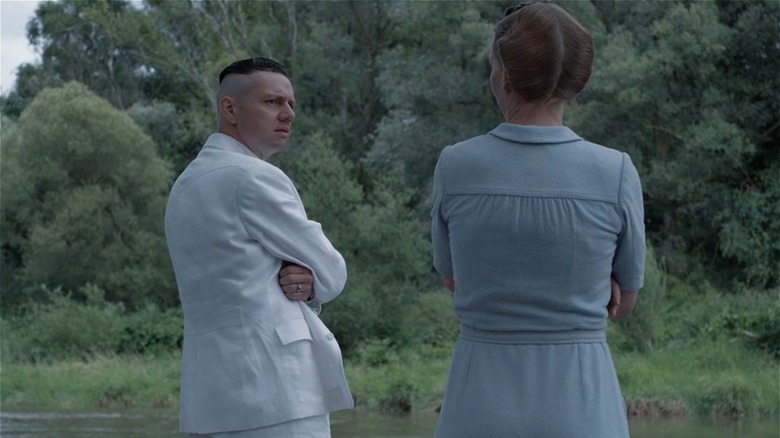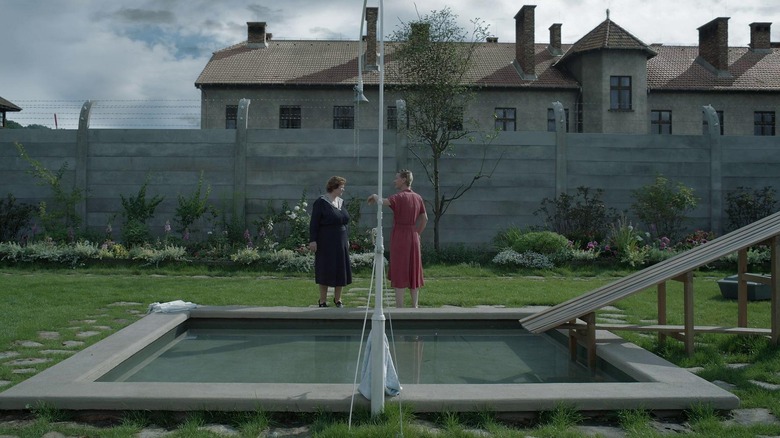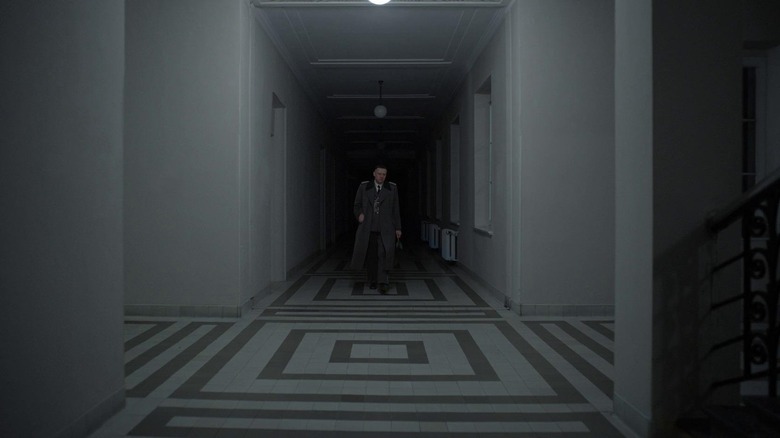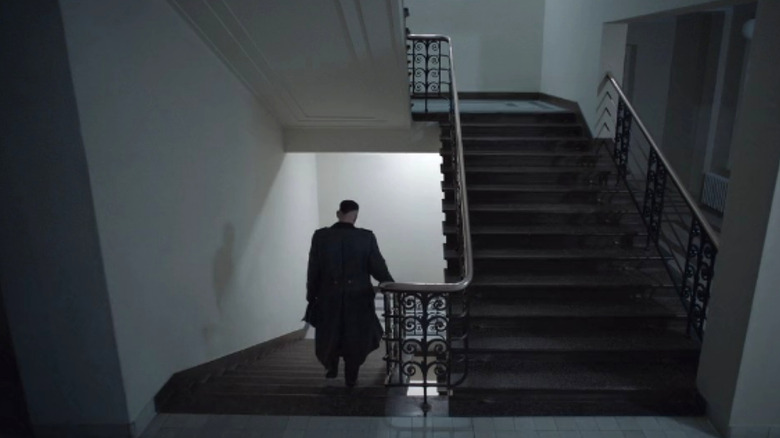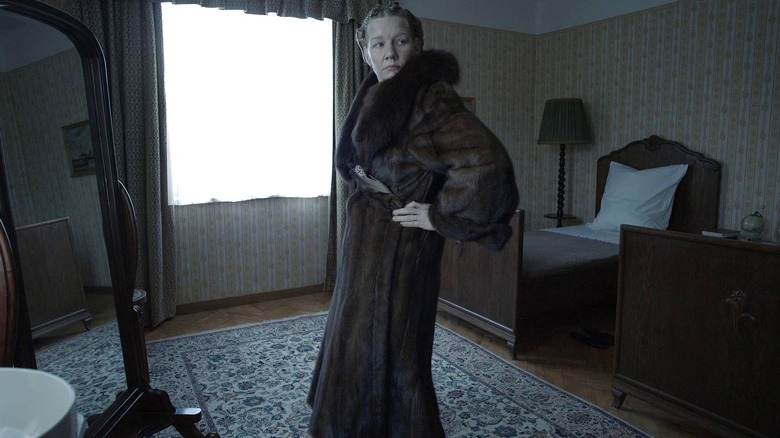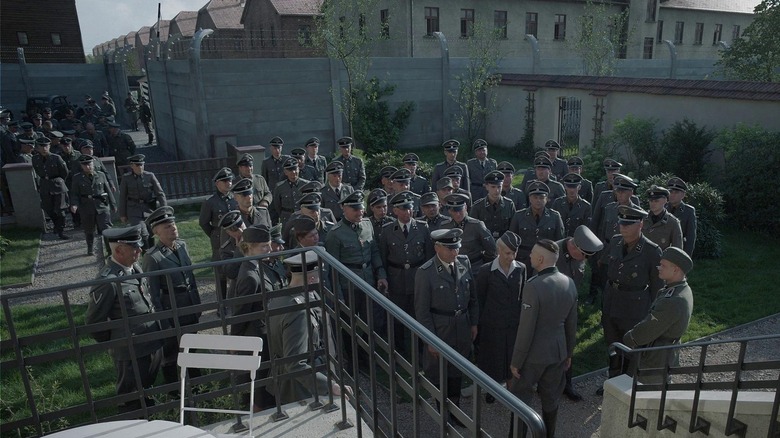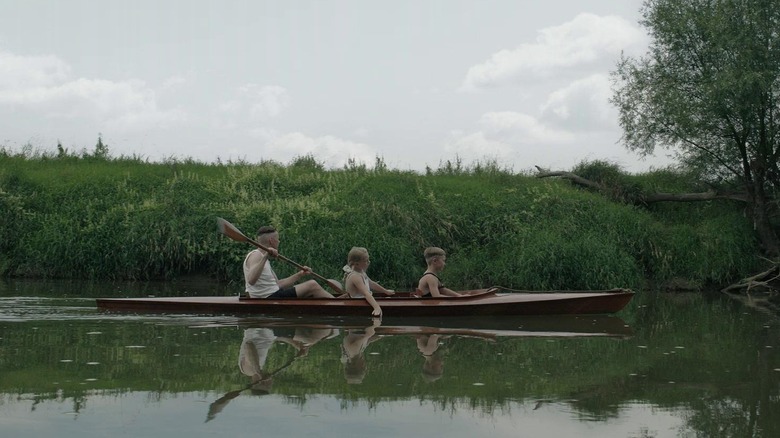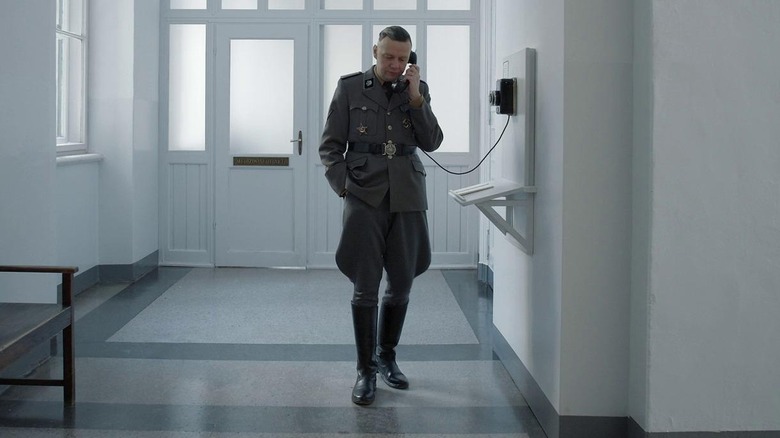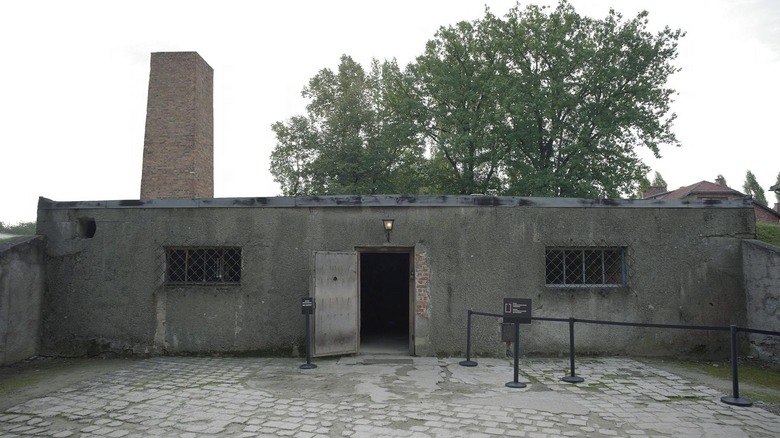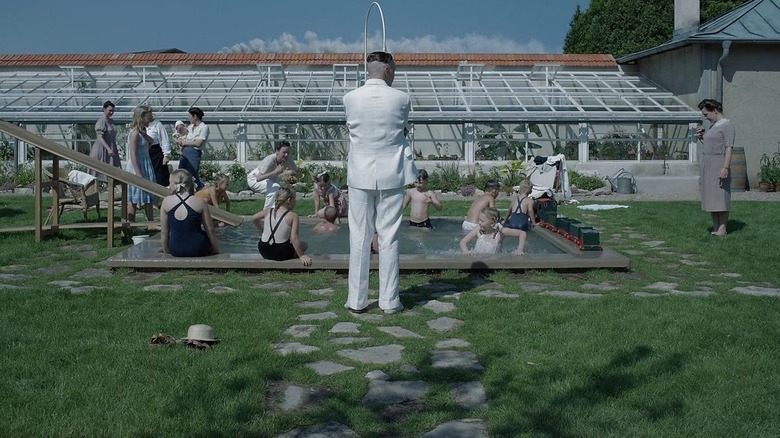We Finally Understand The Ending Of The Zone Of Interest - And It's Truly Disgusting
The Manhattan-based independent studio A24 has spent years asking audiences to find the meaning under the surface, offering thought-provoking films that challenge the viewer's perspective. The biggest A24 movies of all time do this, and 2023's "The Zone of Interest" is no different. Written and directed by Jonathan Glazer, the film takes a look at the Holocaust from the perspective of an Auschwitz commandant who lives near the camp. It took home the Academy Awards for best international feature film and best sound, an element that this movie heavily relies on as it cleverly merges cries and screams into the score to depict the torture happening at the camp.
As Looper alluded to in our review of "The Zone of Interest," the film delivers a poignant statement on the banality of evil and comes with an ending that, when explained, is truly disgusting. Following a lavish party, Commandant Höss descends a dark staircase, coughing and retching, taking breaks in between steps. He then looks toward a black pane with light shining through before the scene cuts to present-day Auschwitz, which is now a museum. All of this adds up to a moment that is reliant on ambient sound, forcing viewers to focus on dissecting the visuals. Glazer delivers a dark ending that will make you sick to your stomach once you understand what's really going on.
What you need to remember about the plot of The Zone of Interest
"The Zone of Interest" follows the commandant of Auschwitz, Rudolf Höss (Christian Friedel), his wife Hedwig (Sandra Hüller), and their children as they live next to the concentration camp in occupied Poland in 1943, two years before World War II ended. The film begins with the family playing in a nearby body of water before returning to their fancy home, where Hedwig receives clothes from the camp — the family get to keep the belongings of the Jewish people being killed next door.
As the film chronicles the everyday conversations and activities of the family, it also punctuates moments of change that impact them and Auschwitz itself. This includes Höss overseeing planned renovations to the camp's interior, increasing the amount of torture. Höss is ultimately promoted to deputy inspector of concentration camps and has to move to Berlin. The film ends with the news that Höss will oversee the transport of hundreds of thousands of Hungarian Jews to various concentration and extermination camps. As he leaves his office, he begins to retch as he stares into a dark corridor.
What does the ending of The Zone of Interest mean?
At the end of "The Zone of Interest," Commandant Rudolf Höss attends a party with fellow Nazis. He then descends a staircase and starts retching. He looks down a dark hallway and the scene cuts to present-day Auschwitz, which is now a museum chronicling the torture that happened while memorializing those killed there. We're left to surmise that the commandant's retching is caused by the sudden realization that he will be remembered as an evil man who callously took an almost unimaginable number of lives.
In this moment, the pure evil of his actions and how his ideas have increased the atrocities of the Nazi party come to surface. He cannot turn back the clock on what he has done. He instead looks toward the future, which is why the scene cuts to present-day Auschwitz. It's a space where Höss was once praised by colleagues and feared by innocent people. Now, it is a place that focuses on how his actions contributed to one of the worst moments in human history.
This explanation of the ending could also better explain Höss' conversation with his wife right before he becomes ill. During their phone call, he tells her that he was thinking about the best way to exterminate everyone at the party. He delivers this line with the same coldness that he displays throughout the film. Given his sudden illness after the call, it seems as though the conversation tipped him over the edge — he can no longer block out the fact that he's had a hand in the torture and murder of so many innocent people.
Another possible explanation for The Zone of Interest's ending
While one explanation of the film's ending is that Rudolf Höss has reached the point where he can no long ignore the evil of his actions, another possible explanation is less psychological and more physical: His sudden retching could be the symptoms of an illness that he contracted while working at and living near the camp. The film shows his deep involvement in planning increased gassing and cremation at Auschwitz, meaning that he would need to be onsite to oversee the renovations. And, given that he lives next to the camp, he is unable to escape the chemicals and ashes potentially polluting the air and water near the house.
Is his retching an on-camera depiction of how his horrific actions have led to him becoming sick? Toward the beginning, a worker washes blood off the commandant's boots upon his return from work. In the middle of the movie, the commandant is swimming with his children when he finds a human jaw bone in the water. They immediately head home where the commandant and his children take baths. Human ash is seen in the tub as the commandant cleans up.
While Auschwitz itself is largely off-camera, its chimneys are well depicted. Scenes of dark, ashy smoke billowing from the chimneys give viewers a vague idea as to what is going on inside. This also shows the possibility of air pollution, meaning that those living in the zone of interest are breathing in human ash and possible chemicals every day for several years. And the air and water are not the only ways that this family is ingesting human remains: One scene shows a worker at the house using human ash to fertilize one of the gardens.
Hedwig's role in the ending of The Zone of Interest explained
Like Rudolf Höss, his wife Hedwig is happy to completely ignore the suffering going on right beside their idyllic home. In many ways, they enable each other in their evil. Hedwig is the last person that Rudolf talks to in the film, and it's a conversation that shows her coldness as they discuss his next task and his idea about exterminating everyone at the party. She doesn't bat an eye at anything he says, and her perspective could be a driving force in why he still believes in his work.
As Rudolph retches, Hedwig continues to live life as she always has. She's clearly attached to the home and the status it gives them in the Nazi world, even demanding that she and the children stay there following the news of Rudolph's transfer. The film shows that Hedwig, like her husband, has used compartmentalization to block out the reality of their situation. She receives clothes from those killed in the camp (including a fur coat) like it's nothing and casually discusses her ill-gotten belongings over a cup of tea with friends.
While she and the commandant clearly had similar mindsets before Auschwitz, Hedwig's emotional disengagement is important in that it allows Rudolph to put the reality of what he does out of mind the moment he steps foot in his home. The fact that Rudolph became ill after speaking to Hedwig on the phone may not be a coincidence — the fact that she wasn't moved in the slightest after Rudolph told her that he spent his meeting in Berlin thinking about the most efficient way to gas everyone in attendance may have been the thing that actually opened his eyes.
How historically accurate is The Zone of Interest?
Rudolf Höss was a real commandant at Auschwitz, taking command in 1940. More than one million people were killed at the camp, and Höss was its longest-serving commandant. As depicted in "The Zone of Interest," the Höss family lived nearby in a seemingly peaceful home located in the area the film is named after, a 16-square-mile zone administered by the Schutzstaffel (aka the SS) that was off limits to the public. As is shown in the film, much of the family's goods were taken from the camp. According to Time, the real villa is a two-story building that is complete with a garden, like that depicted in the movie. The children also played in a nearby river, just like they do in "The Zone of Interest."
Höss wrote an autobiography called "Commandant of Auschwitz" after his eventual capture, and in it, he claimed that his wife Hedwig was unaware of the horrors going on in the camp. However, as Smithsonian Magazine points out, this is likely untrue. "The evidence suggests otherwise," the mag's Senior Associate Digital Editor Meilan Solly wrote. "The Hösses lived a life of luxury, employing camp inmates as forced laborers and seizing items confiscated from the dead, including expensive furs, cooking supplies like sugar and flour, jewelry, and leather goods."
How did it end for the Höss family in real life?
In real life, Rudolph Höss oversaw the transport of more than 400,000 Hungarian Jews to Auschwitz in what is known as Operation Höss. The movie is true to those events, but what it doesn't show us is what happened after the fall of the Nazis. When the Allies won the war, many Nazis tried to flee to South America. Höss, however, stayed in Germany, taking the fake name Franz Lang and moving to Flensburg to work on a farm. In the end, his location was given up by none other than Hedwig.
As sticking together would have made capture more likely, Hedwig and the children separated from Rudolph, taking refuge in an old sugar factory in St. Michaelisdonn. They were able to evade capture for a full year, but the search was being led by a man determined to see justice done — Hanns Alexander, a German Jew who saw the writing on the wall in the 1930s and decided to move to London. He came back to Germany with some British soldiers to hunt for war criminals, and they managed to track down Hedwig and the Höss kids.
"My older brother Klaus was taken with my mother," Rudolf and Hedwig's daughter Brigitte would later reveal (via The Washington Post). "He was beaten badly by the British. My mother heard him scream in pain from the room next door. Just like any mother, she wanted to protect her son, so she told them where my father was." Rudolph denied being who he was when the Brits found him on his farm, but his wedding ring (inscribed with his and Hedwig's names) gave him away. He met his end at the scene of his most horrendous crimes, getting hanged at Auschwitz.
What has Christian Friedel said about the ending of The Zone of Interest?
For Christian Friedel, playing Auschwitz commandant Rudolf Höss meant searching for moments to express emotion and humanity in an evil person, all in an effort to step away from clichés while at the same time not glorifying him. He told The Hollywood Reporter, "The challenge was to find those moments, to think about where they come from and to try and find a connection with my own personality. It was a difficult search, but I thought I needed to do that so that we didn't show him as just the monster, just the criminal."
It's this approach that makes the ending more intriguing for audiences who are trying to figure out whether his illness is from regret or a physical sign that being in close proximity to the camp has made him sick. Friedel told The Film Stage, "I was really afraid of this scene because Jonathan is searching for the truth, and I would describe the whole shoot as a search." Friedel believes that Höss retching in the final moments of the movie is a manifestation of his deeply buried demons coming to the surface. "Because the body tells the truth and our mind, we can betray ourselves. We are masters of self-deception," he said.
The actor also told The Wrap that his first viewing of the completed film was the first time he saw the final cut of the ending, and it was an impactful moment. "The ending was in the script, but not in the way that Jonathan decided to edit it. I saw the movie for the first time with Sandra [Hüller, who plays his wife Hedwig]," he revealed, adding, "And when that ending came, we both said 'Wow' out loud because it was so challenging."
Why was present-day Auschwitz shown at the end of The Zone of Interest?
Why did director Jonathan Glazer take us to present-day Auschwitz at the end of the film? Glazer told Rolling Stone that he came up with the idea after visiting the now-museum, watching workers as they cleaned and prepared for another day of visitors. "It was like they were tending graves. You know, Höss is long gone. He is ash. But the museum, and the importance of such museums, they are still there," he said. By incorporating the museum into the ending, Glazer said he was able to explicitly make the connection between the past and the present.
When Glazer visited Auschwitz while prepping for the film, he wasn't even sure that he wanted to make it. However, being in the camp and seeing the Höss house in person shook the filmmaker to his core, allowing him to appreciate just how evil those running it were. "Being there, in that space — what struck me was the proximity of it to the camp," he said. "The house shared a wall with Auschwitz. It was all happening right there, on the other side of that wall. And the fact that a man lived there, and brought up his family there... How do you do that? How black a soul must be?"
The film has been a critical hit (it boasts a 93% score on Rotten Tomatoes), which is of course pleasing for Glazer. That being said, the London-born director is ready to put the project behind him, as all the research he did for the project really took a toll on him. "I have bookshelves at home that are heaving with books on this subject, and I'll glad to be rid of them and put the making of this behind me," he said. "It's been quite a journey, and not an easy one."
How The Zone of Interest differs from the book it's based on
The film is loosely based on the book "The Zone of Interest," written by Martin Amis. The 2014 novel follows three characters, one of them being camp commandant Paul Doll, who becomes wary of the relationship between his wife and a Nazi officer named Angelus Thomsen. The story also follows a Jewish prisoner named Szmul Zacharias. Jonathan Glazer told Rolling Stone that the novel's central love triangle was an idea he wanted nothing to do with. However, he wanted to tell a story from the viewpoint of those running the camp, which is a central part of the book.
"There was a courage in the book, in that it absolutely committed to the wholehearted expression of that mindset in an extremely uncomfortable way," Glazer told the mag. "There is a love triangle in it, which... we had no interest in that. But once I began reading it, the novel became a kernel for me. It was just a spark, but a very, very important spark." While Glazer's ending focuses on one person and their look into the future, the ending of the novel is split up into several parts that detail the futures of multiple characters. This includes Doll, who is hanged for his crimes. It's an ending that is more historically accurate considering that the character is seemingly based on Rudolf Höss.
If you're a history buff who loves war films, take a look at Looper's list of movies about World War 2 that are perfect for every history fan. Or, if you're here because you're a fan of Glazer's work, then check out our ending explainers for "Under the Skin" and "Birth."
